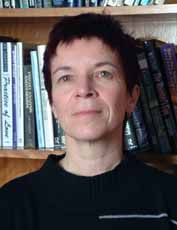Sachs Lecturer Elizabeth Ellsworth Explores “Time, Space and Place” in Pedagogy
Building on concepts she outlined in her first Sachs presentation on December 4th, Ellsworth focused on pedagogical designs embedded in several innovative environments, events and experiences. These included architect Frank Gehry's design of a new MIT campus building, several museum exhibits, and a multi-dimensional event produced by Oakland, California, educator Suzanne Lacey "that can be placed at the intersection of education, art and performance art," Ellsworth said. As in her inaugural lecture, Ellsworth illustrated her remarks with a rich array of multimedia aids.
Designed to explore tensions between local high school students and police, the Oakland event encompassed a range of experiences over the course of four months. "Lacey staged a ‘performance ball game' which involved a dialogue-and ultimately an exchange of views and experiences-between the teenagers and the police," Ellsworth said. "On another night, the participants took over a rooftop parking lot, where video monitors showed documentary films produced by the kids about their experiences with the police. The police watched from their cars, while helicopters hovered overhead." The event transformed "a menacing environment of conflict into one of communication and altered senses of selves and others," she said.
Importantly, arriving at that juncture required neither the police nor the students to forfeit their identities and emulate each other. "In the transitional space created by the participants, the students and police changed-but that change enabled a new and unanticipated way of relating to each other," Ellsworth said. Such experiences, she added, "reflect an interesting mix of humility and excitement on the part of all concerned. The teacher doesn't go in saying, ‘I will employ these specific teaching strategies and this is what will happen,' but, rather, ‘I will be curious about what we can do with this pedagogy and make of it together.' This approach positions the teacher as a producer of culture, rather than simply as a reproducer of culture."
Ellsworth will present her third Sachs lecture, entitled, "Reorienting Education," on February 12th. "It starts from the premise that there are things a teacher can never know in a pedagogical relationship, and that not knowing opens the way to a new kind of pedagogy evident in these various spaces and events," she said. "If we buy into that idea, then what are the implications for broader questions of social responsibility and the ethics of the teaching relationship?" Those questions derive from psychologist D.W. Winnicott's teachings about transitional space, she said, "and lead to the idea of an open future, which is what these experiments and inventions seem to be gesturing toward-especially when teaching about and across social differences."
Ellsworth will also advance the notion that "democracy is by definition always in the making and never achieved, and that that is both its challenge and beauty." If democracy were to be finally achieved, she said, "it would be closed to the future and soon become oppressive. The only thing that keeps a democratic process from becoming oppressive is that it is unfinished." Likewise, a pedagogy that draws upon the idea of transitional space "is one that gestures towards an open future. It addresses the future in a way that tries not to close it down, and it puts what we can't know to productive use."
How does she size up the current state of U.S. education? "Its pedagogies operate all along the continuum, from open to closed," she said. "Even in the most repressive school districts, you'll find amazing teachers doing amazing things." One of the things that makes education survivable as a profession, she said, "is the way teachers can find the spaces between open and closed on a daily basis, and thrive at least momentarily in those spaces."
Ellsworth is quick to note that there is more to education than "acquiring metaphorical knowledge about arts and self-expression." There is no denying that, to function in the real world, students must learn complex, precise kinds of information, she said. "That said, there are some amazing ways to support learning that kind of information that relate it to broader issues and concerns. An awareness of transitional space can help us to take even the most difficult technical information and offer it in forms that invite students to discover it and put it to use for themselves."
A leading proponent of using media to enrich learning experiences and foster social change, Ellsworth taught at the University of Wisconsin-Madison from 1984-2002. During the past two years, she has served as both Visiting Professor in TC's Philosophy and Cultural Studies Programs and Director of Educational Programs for Teachers College Innovations. A recipient of grants and awards, Ellsworth has published numerous articles and four books, including Teaching Positions: Difference, Pedagogy, and the Power of Address (Teachers College Press, 1997).
Published Monday, Feb. 10, 2003
